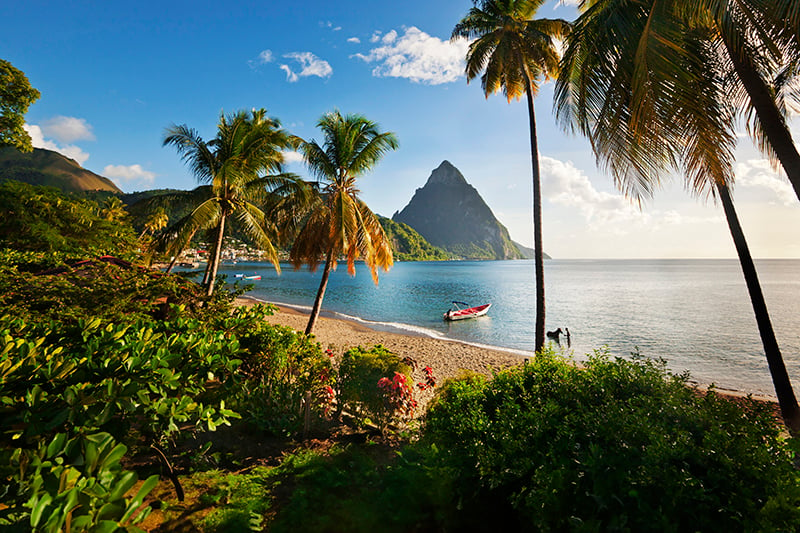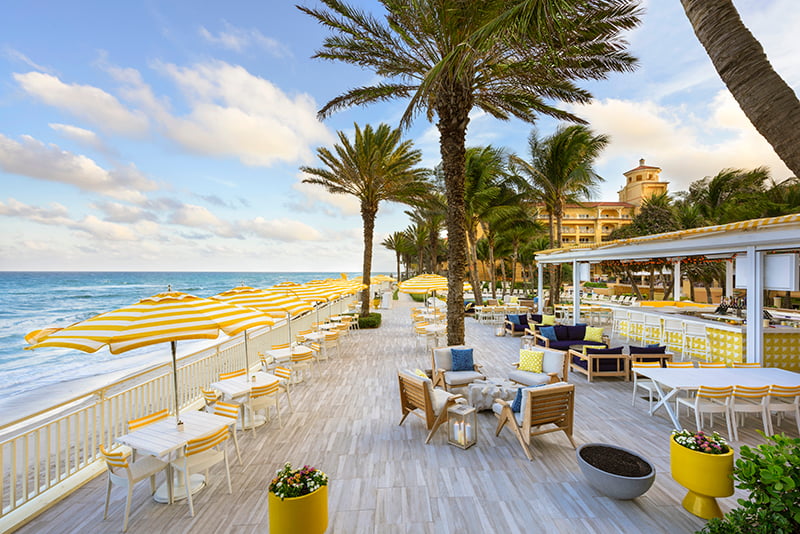Travel From CLT: Saint Lucia
The eastern Caribbean island blends a unique history with spectacular mountains and beaches, a drive-in volcano, and one of the world’s best music festivals

MILES FROM CHARLOTTE: 1,925
TRAVEL TIME: 4 hours, 25 minutes
NONSTOP
SERVICE ON: American Airlines
It’s Caribbean Fusion night at the Saint Lucia Jazz & Arts Festival, and an older gentleman in black-framed glasses and a light-blue cap croons onstage about how he feels good when he’s wrapped up in your arms. His band pulses out an insistent reggae beat. The throng that floods the field before him sways and bops to the music: men in pastel-colored island shirts, women in loose-fitting chartreuse and blood-orange dresses.
I stroll the perimeter of the main stage at Pigeon Island National Landmark, with its ruins of stone buildings from when the French and British fought over this island throughout the 17th and 18th centuries. The aromas of fried fish and baking bread drift in the warm, humid air—it’s only May, but Saint Lucia lies at the southeastern edge of the Caribbean, and it’s 83 degrees even at 11 p.m.
To the left and behind the stage, scattered radios and speakers emit reggae, ska, calypso, hip-hop, soca, and contemporary pop, a shape-shifting sonic blend. The sounds wash over tented boutiques as people mill and chat, cops in uniform fan themselves, four-wheelers scurry, and workers hustle at food booths, so many food booths. Over here, next to a calabash tree: Wingz N Tingz. Nearby: Eugenie’s Delight, which serves, among other delicacies, “Creole Octopus.” Around a bend in the dusty access road: Kiye Kil’tay Kweyol Bakery, which sells fresh bread with saltfish, salami, cheese, or butter. The staff bakes loaves beside the tent, over hot coals in ovens made from 55-gallon drums, even in this heat.
Here’s what I don’t encounter, even among hundreds: a hint of aggression or even tension. Everyone’s chill and happy. “Yeah, yeah, yeah!” the man in the blue cap yells, to cheers. Beres Hammond is a 68-year-old Jamaican reggae singer known throughout the Caribbean for his lilting tunes about the pleasures of romance. “Just checking, just checking, just making sure you’re still out there. … Let me hear you say, ‘Irie!’ So much love! So much love! So much love!”
And in such a small package: Saint Lucia is a teardrop-shaped volcanic island amid the Lesser Antilles, a chain that curves like a closing parenthesis southward from the Virgin Islands toward South America. At 238 square miles, the island is smaller than the 308-square-mile city of Charlotte. It’s also way south—far closer to the Venezuelan coast than to, say, Puerto Rico—which helps explain why the island’s tourism industry developed later than some of its counterparts to the north and west. The country opened its first cruise port, near the capital city of Castries, only in 1987.
Tourism expanded quickly. Spring was a fallow season, though, and organizers launched a modest, poorly attended jazz festival in May 1992. By mid-decade, the festival had grown to encompass other musical styles, and by its 10th anniversary, it was a 10-day, multisite event.
Among the artists who have performed: George Benson, Mary J. Blige, Herbie Hancock, Elton John, and Amy Winehouse. Sting and Shaggy headlined the 2023 festival, the first after a three-year COVID hiatus. The 2024 festival welcomed Babyface, Trinidadian soca star Machel Montano, Nigerian Afrobeats artist Davido, and the venerable Australian soft-rock duo Air Supply. (This year’s lineup was pending as of November—check the festival website for updates.)
Charlotteans can get there with surprising ease. In recent years, American Airlines has offered daily nonstop flights to and from Hewanorra International Airport, on Saint Lucia’s southern tip. The four-and-a-half-hour flights have helped boost Saint Lucia’s accessibility for U.S. East Coast tourists.
Most acts perform after sundown, which gives visitors a chance to explore beyond festival and resort grounds during the day. In Castries—population about 34,000, Saint Lucia’s largest city and commercial hub—more than 300 vendors peddle fresh fish, spices, rum, fruit, clothes, packets of dried sea moss, and Jah knows what else in the city’s massive open-air market. (One vendor’s booth arranges the following items in close proximity: turpentine, turmeric, and grenadine.) After a two-hour ramble, I sample a fruit vendor’s fresh juices: tamarind, mango, passion fruit, soursop, starfruit, guava, papaya. All delicious, but they barely dent my thirst. A sun hat and sunscreen, not to mention water, are essential if you roam by day.

Vendors sell mangoes and other native fruits (above) at the central market in Castries, the capital city.
That goes double if you make the trek, by car or boat, to Soufriere, a town of about 3,000 on the southwestern coast. Soufriere puts you close to Saint Lucia’s most prominent physical landmarks: the twin peaks of the Pitons, Gros and Petit, mountains represented on everything from the national flag to the name and label of Saint Lucia’s best-known beer; and Sulphur Springs, with its mud baths and drive-in volcano. I am not kidding about this. (Details on next page.)
But you come back to, and for, the music. The night before Caribbean Fusion, I take a seat in a nearby pavilion for Pure Jazz night. The theme: Ladies in Concert. The headliner is Samara Joy, a New York City-born phenom who, at 24, has already won three Grammys, including Best New Artist. Onstage, in a fuchsia dress, Joy glides through a song from her new album, Portrait: “Reincarnation of a Lovebird,” a 1960 Charles Mingus instrumental for which she, with no lack of confidence, has written lyrics. I listen in astonished silence, like the rest of the crowd, and think: This is what it must have been like to hear Ella Fitzgerald in the 1930s.
STAY
The 289-suite Royalton Saint Lucia is one of 11 all-inclusive resorts clustered at the northern end of the island, near the festival site and about 10 miles north of Castries. It offers everything a tourist could ask for: nine restaurants, seven bars (including two swim-ups), multiple swimming pools, beach access, and a first-rate spa. Suites come with super-comfortable beds, rain showers, balconies that overlook the grounds and ocean, and Jacuzzi tubs. The Royalton offers a complimentary shuttle service to and from the airport if you book directly through the hotel.
EAT
You don’t have to leave the Royalton, which boasts Gourmet Marché, an international buffet open for breakfast, lunch, and dinner; Grazie Italian Trattoria, with pasta dishes and gourmet pizzas; Zen, a teppanyaki restaurant with engaging grill masters; and more. If you explore the bustling streets of Castries, choose from a range of food booths and city market eateries like Lynn’s Cuisine, a humble alleyway kiosk that serves affordable, traditional island fare like this representative dish: pork, lamb, or fish with lentil stew over rice, noodles, breadfruit, plantains, and macabo. It’s like a Caribbean meat-and-three. (At some point, sample Saint Lucia’s national dish: boiled green bananas and salted cod.) If you’re in or near Soufriere, it’s worth a car trip up a winding mountain road to Soley Kouche. Sorin and Diana Moldovan, originally from Romania, opened a Caribbean-influenced fine dining establishment in 2023. It clings to a hillside with a breathtaking close-up of Gros Piton, the Caribbean, and the beach below. On clear days, you can see the neighboring island of Saint Vincent, about 35 miles south.
PLAY
You could do worse than frolic in the resort pools or with yellow-and-black sergeant major fish in the shallows off the beach. You also can dig the views (and flying fish!) during a boat trip to Soufriere. But if you go there, stop by the nearby Toraille Waterfall, which drops a 50-foot torrent of cool water on the heads of the sweaty. Then head to the volcano and drive on in. Don’t worry, it’s dormant, having last erupted in the 18th century. But the Sulphur Springs are still part of a geothermal field. You can see the steam (and see and smell the sulfur) that rises from barren rocks around the recessed mud baths, the island’s most popular tourist destination; about 200,000 people visit every year. Soak in hot, dark-gray water that bubbles with minerals believed to detoxify the body and relieve aching joints, arthritis, even sunburn. Then coat yourself with mineral mud, let it dry, rinse off in another pool, and wash any residue off under one of the on-site showers or a nearby waterfall. Warning: Wear a dark swimsuit, and hydrate.








